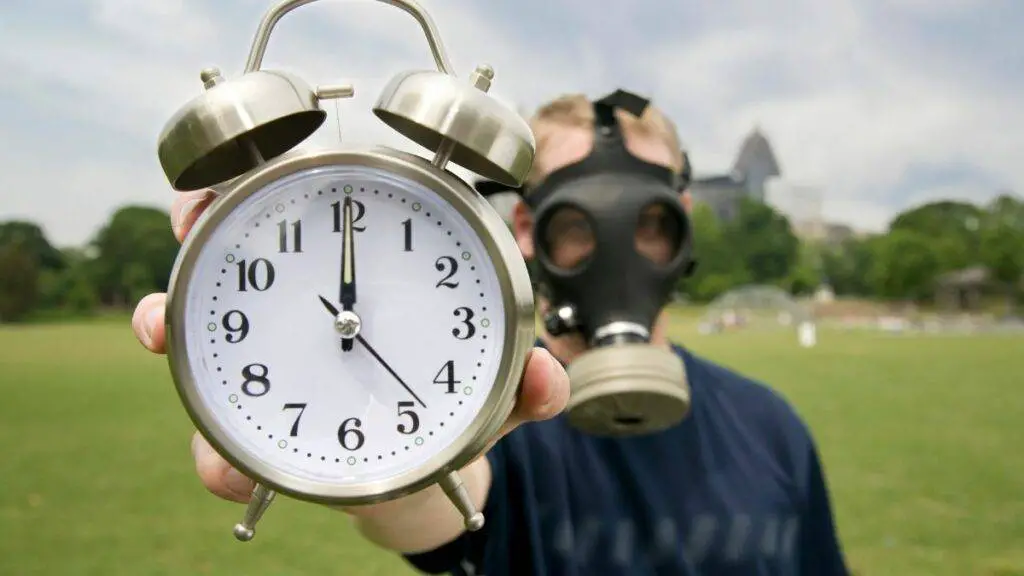Have you ever found yourself pondering just how many seconds in a day exactly are there? Trust me, you’re not the only one. This question, simple as it seems, piqued my interest and sent me on an exploration journey into the enchanting world of time conversions.
Consider this article your comprehensive guide that unravels the number of seconds in a day. And here’s an intriguing nugget for you – leap years toss in an extra 86,400 seconds! So buckle up and prepare to have your mind dazzled by the powerful dance of numbers!
Key Takeaways
- A day has 86,400 seconds, which comes from multiplying 24 hours by 60 minutes and then by 60 seconds.
- In a leap year, there is an extra day that adds another 86,400 seconds to the total.
- The Doomsday Clock represents global risks like nuclear weapons, climate change, biological threats, and disruptive technologies. It currently stands at 90 seconds to midnight.
- Smart water filters are the latest innovation in water filter technology. They monitor water quality, connect to smartphones through apps, target specific contaminants while preserving essential minerals, and help reduce plastic waste.
How Many Seconds are in a Day?

The definitive answer to how many seconds are in a day will finally be unveiled, providing clarity and precision.
The definitive answer
A day has 86,400 seconds. This comes from multiplying 24 hours in a day by 60 minutes per hour, and then again by 60 seconds per minute. But there’s more! In a leap year, we get an extra day.
That adds another 86,400 seconds to the total! So that year will have a grand total of 31,622,400 seconds. This is how you turn one year into all its precious moments!
Time Converter – Convert Any Time Unit into Seconds
To use the Time Converter provided below, simply start by selecting the desired time unit from the dropdown menu, such as years, months, weeks, days, hours, or minutes. Then, input the numerical value you want to convert into the “Enter a value” box. For instance, if you’re converting 6 months, type “6” into the input box. After that, click the “Convert” button, and the tool will swiftly calculate the equivalent time in seconds based on your selection. The result will be displayed below the button, formatted as “Result: [number] seconds.” This user-friendly tool makes it effortless to convert different time units into exactly seconds for a variety of applications.
Time Converter into Seconds
Understanding the Doomsday Clock

The Doomsday Clock is a symbol that represents the level of global risk related to nuclear weapons, climate change, biological threats, and disruptive technologies. It is a time of unprecedented danger that requires our attention and action.
A time of unprecedented danger
In today’s world, we are living in a time of unprecedented danger. The threats we face extend beyond traditional conflicts and encompass new risks that could have catastrophic consequences.
These dangers include nuclear weapons, climate change, biological threats, and disruptive technologies. The Bulletin of the Atomic Scientists even sets a “Doomsday Clock” to illustrate how close we are to global catastrophe – currently only 90 seconds away from midnight.
It is crucial for us as job seekers to be aware of these challenges and consider how our skills can contribute to addressing them.
Nuclear risk
Nuclear risk is a major concern in today’s world. It refers to the potential dangers and threats associated with nuclear weapons and power plants. The Bulletin of the Atomic Scientists, an organization focused on global security issues, tracks the risk level through their Doomsday Clock.
Currently, the clock is set at 90 seconds to midnight, indicating a time of unprecedented danger. This highlights the urgency and importance of addressing nuclear risks to ensure a safer future for all.
Climate change
Climate change is a serious issue that affects our planet. It refers to long-term changes in temperature and weather patterns caused by human activities like burning fossil fuels. This leads to an increase in greenhouse gases, trapping heat in the atmosphere and causing global warming.
Climate change has many negative impacts, such as rising sea levels, extreme weather events like hurricanes, droughts, and floods, and the loss of biodiversity. It is important for job seekers to be aware of climate change because it can affect industries such as agriculture, tourism, and renewable energy.
Taking steps to reduce our carbon footprint and mitigate climate change is crucial for ensuring a sustainable future for ourselves and future generations.
Biological threats
Biological threats are a serious concern in today’s world. They refer to the potential dangers posed by infectious diseases, viruses, or biological agents that can cause harm to humans, animals, and plants.
These threats can arise from natural sources like outbreaks of new viruses or from intentional acts of bioterrorism. It is important for job seekers to be aware of these threats because they may impact various industries such as healthcare, public health, emergency management, and research.
Understanding the risks and taking necessary precautions can help ensure safety and preparedness in dealing with biological threats.
Disruptive technologies
Disruptive technologies are innovative advancements that can significantly change the way we live and work. They disrupt traditional industries and create new opportunities for job seekers.
Some examples of disruptive technologies include artificial intelligence, blockchain, virtual reality, and 3D printing. These technologies have the potential to revolutionize various sectors like healthcare, finance, manufacturing, and transportation.
Job seekers who are knowledgeable and skilled in these disruptive technologies will have an edge in today’s competitive job market. It is essential to stay updated with the latest trends and acquire the necessary skills to adapt to these technological changes effectively.
About the Bulletin of the Atomic Scientists
The Bulletin of the Atomic Scientists is an organization that focuses on global security and nuclear threats. They created the Doomsday Clock, which symbolizes how close we are to a major catastrophe.
Currently, the clock is set at 90 seconds to midnight, indicating that we are in a time of significant danger. The scientists consider factors such as nuclear risks, climate change, biological threats, and disruptive technologies when determining the time on the clock.
Their mission is to raise awareness about these issues and promote international cooperation for a safer world.
Converting Time into Seconds
To convert time into seconds, we can start by converting one year into seconds.
Converting one year to seconds
To convert one year to seconds, we need to break it down into smaller units of time. A year has 365 days, and each day has 24 hours. In turn, each hour contains 60 minutes, and each minute consists of 60 seconds.
So, to calculate the number of seconds in a year, we multiply the number of days (365) by the number of hours in a day (24), then by the number of minutes in an hour (60), and finally by the number of seconds in a minute (60).
This calculation gives us a total of 31,536,000 seconds in one year. That’s quite a lot!
Conclusion
In conclusion, the article did not provide the definitive answer to how many seconds are in a day. It briefly mentioned the calculation process but did not give a specific number. However, understanding that a day consists of 24 hours, each hour has 60 minutes, and each minute contains 60 seconds can help us estimate the total seconds in a day.
FAQs
1. How many seconds are there in one day?
There are 86,400 seconds in one day if we use the seconds in a day calculation or formula.
2. Can I convert hours to seconds?
Yes, you can change hours into seconds using the right conversion method.
3. Is there a tool like a calculator for changing days into seconds?
Yes, you can find a ‘seconds in a day’ calculator online to do this job easily.
4. What is the duration of a week measured in seconds?
A week has 604,800 seconds when you add all the daily second totals together for seven days.
5. What does chronology have to do with how long an hour is?
Chronology is about timekeeping and it helps us know that each hour has 3600 seconds.
